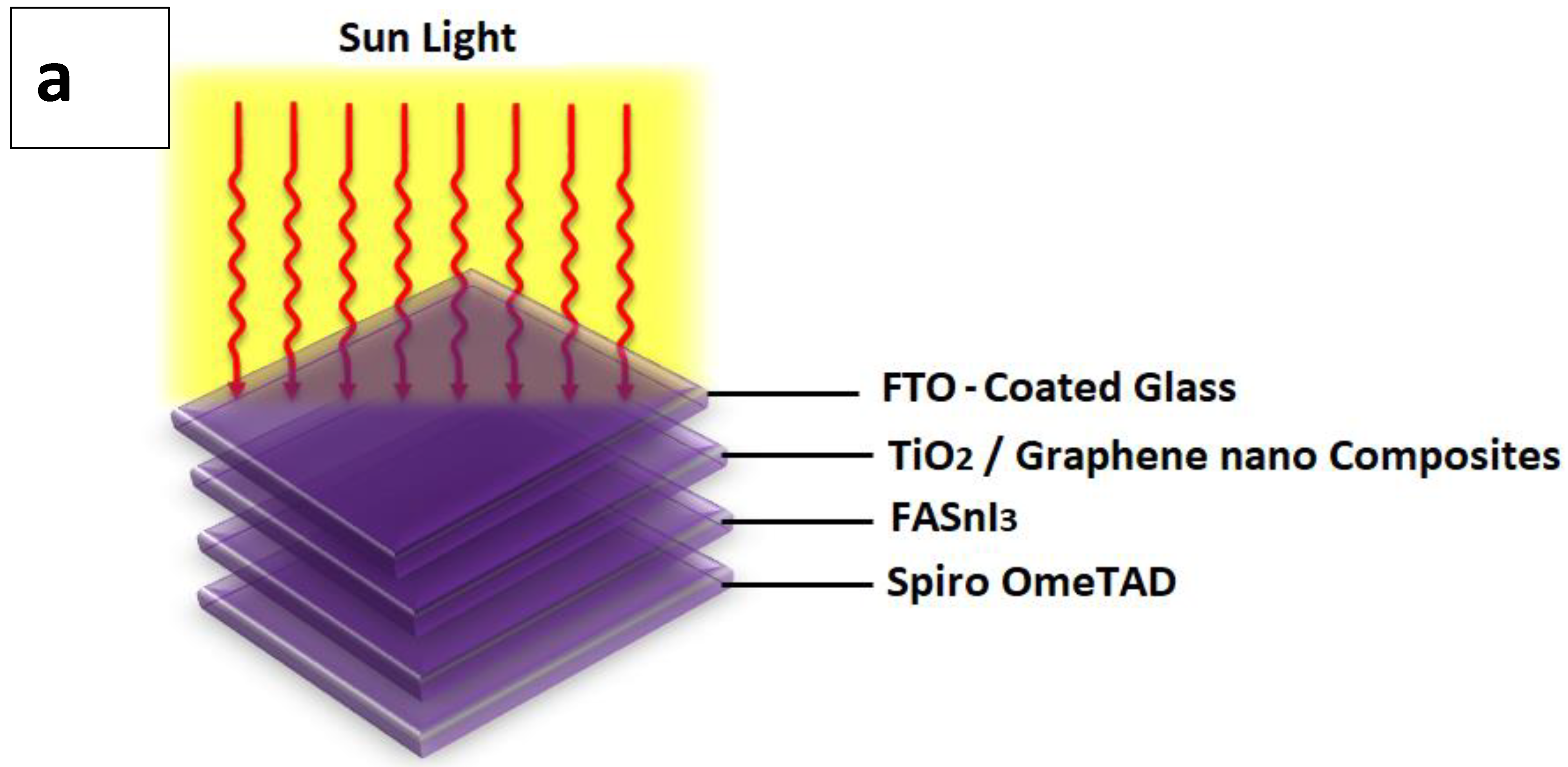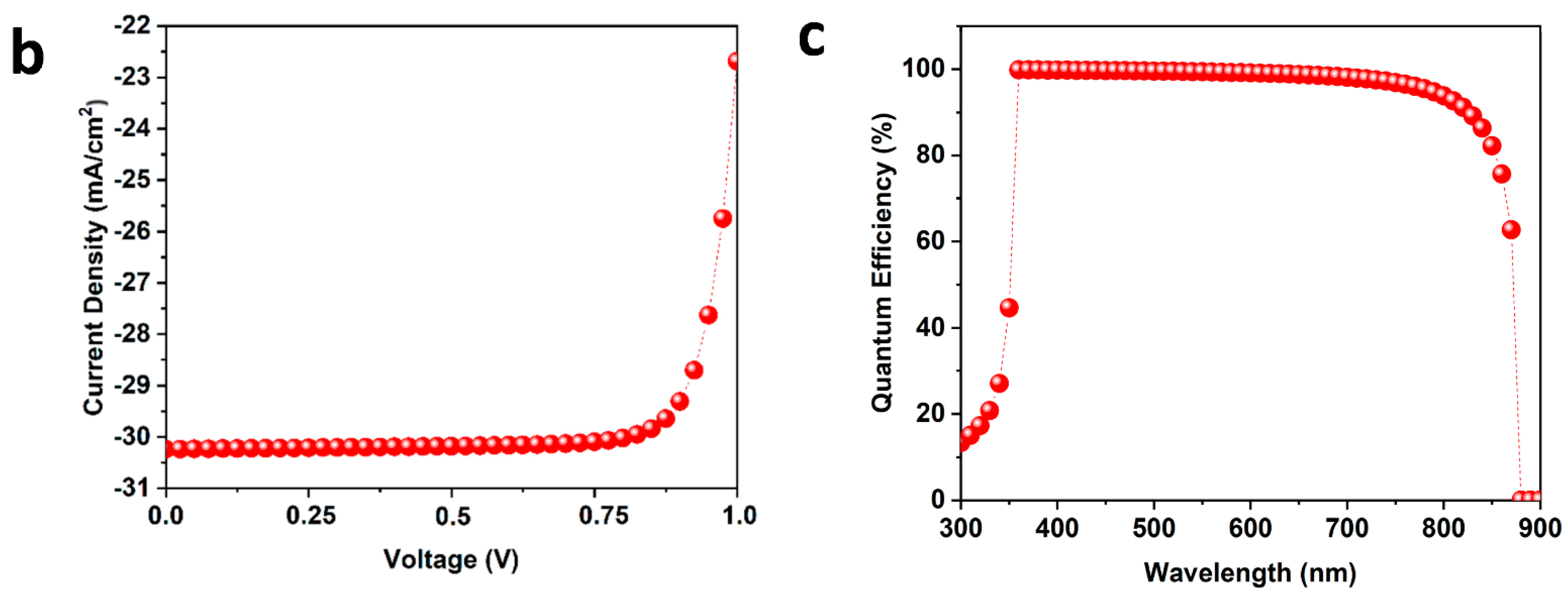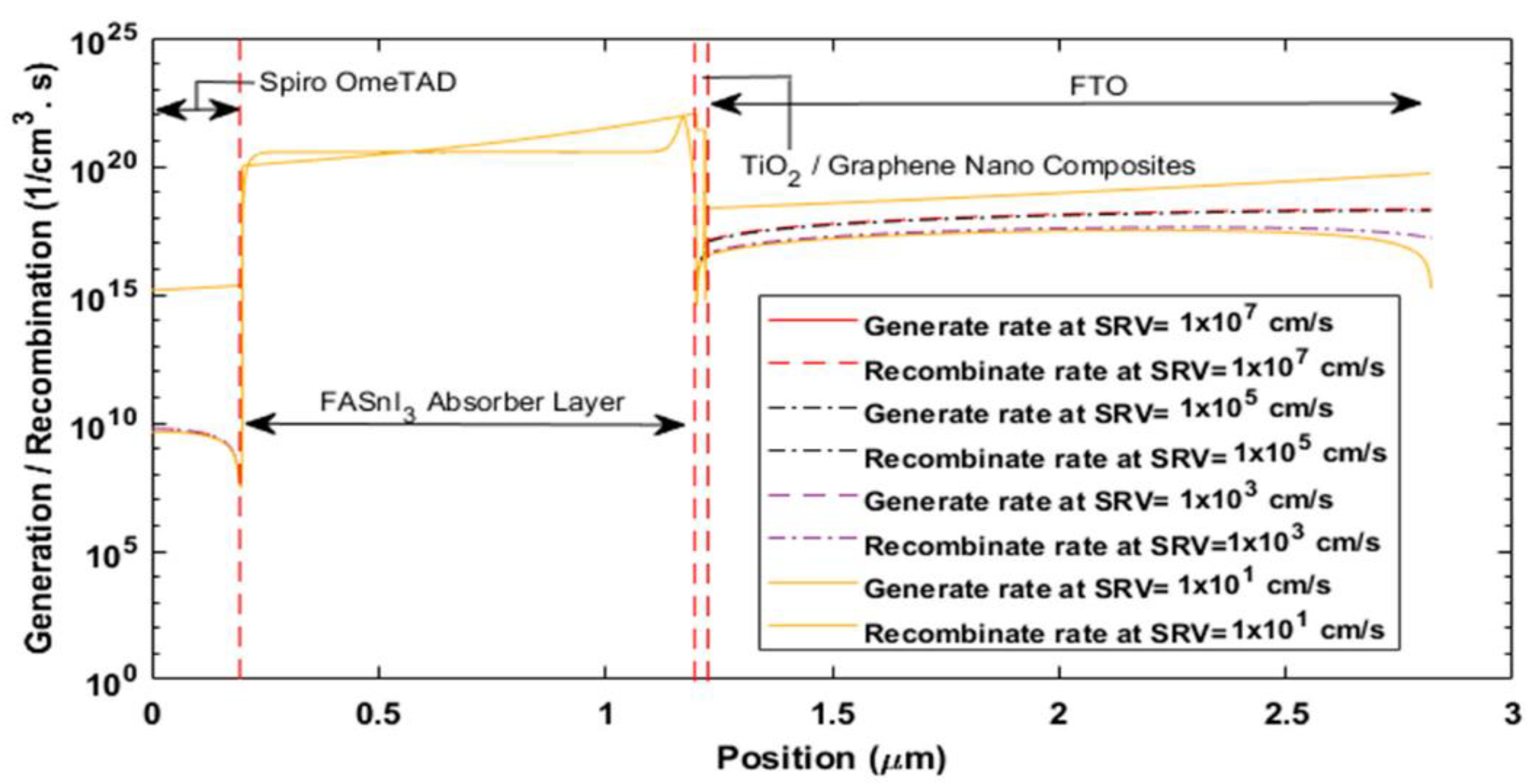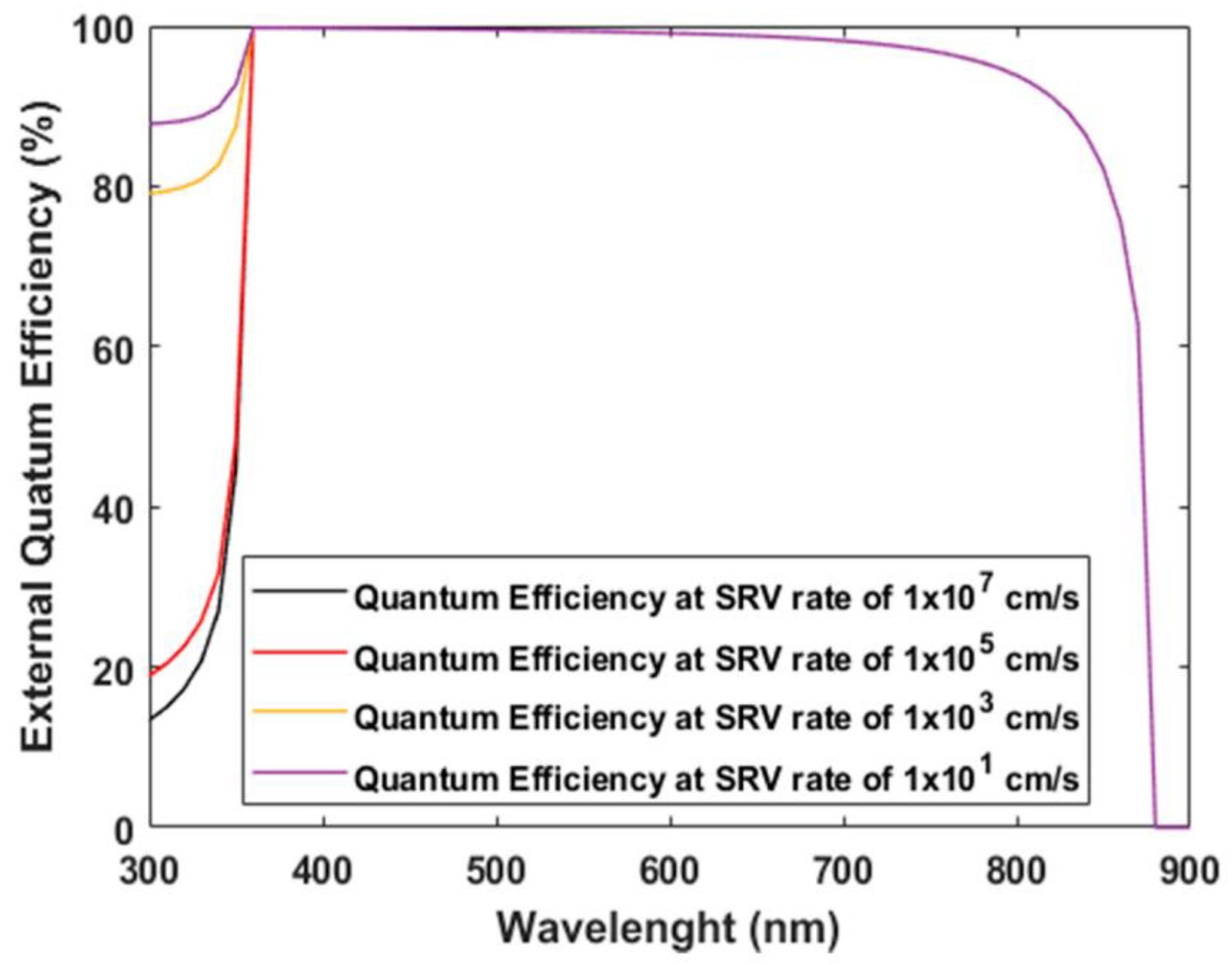Unveiling Surface Recombination Velocity Influence on the Device Characteristics for the Formamidinium Perovskite Solar Cell †
Abstract
:1. Introduction
2. Materials and Methods
3. Results and Discussion
3.1. Surface Recombination Velocity Effect on Current–Voltage Characteristics
3.2. Surface Recombination Velocity Effect on Generation/RecmobinationRate
3.3. Surface Recombination Velocity Effect on External Quantum Efficiency
4. Conclusions
Author Contributions
Funding
Conflicts of Interest
References
- Ashworth, C. Reproducible, high-performance perovskite solar cells. Nat. Rev. Mater. 2021, 6, 293. [Google Scholar] [CrossRef]
- Jung, J.W.; Son, S.H.; Choi, J. Polyaniline/reduced graphene oxide composites for hole transporting layer of high-performance inverted perovskite solar cells. Polymers 2021, 13, 1281. [Google Scholar] [CrossRef] [PubMed]
- Saeed, F.; Tauqeer, H.A.; Idrees, A.; Ali, M.Z.; Raza, A.; Khan, M.A. Buffer Layered PbS Colloidal Quantum Dot Solar Cell with Enhanced Efficiency. In Proceedings of the 2021 4th International Conference on Energy Conservation and Efficiency, ICECE 2021, Lahore, Pakistan, 16–17 March 2021. [Google Scholar]
- Jeong, J.; Kim, M.; Seo, J.; Lu, H.; Ahlawat, P.; Mishra, A.; Yang, Y.; Hope, M.A.; Eickemeyer, F.T.; Kim, M.; et al. Pseudo-halide anion engineering for α-FAPbI3 perovskite solar cells. Nature 2021, 592, 381–385. [Google Scholar] [CrossRef] [PubMed]
- Jariwala, S.; Burke, S.; Dunfield, S.; Shallcross, R.C.; Taddei, M.; Wang, J.; Eperon, G.E.; Armstrong, N.R.; Berry, J.J.; Ginger, D.S. Reducing surface recombination velocity of methylammonium-free mixed-cation mixed-halide perovskites via surface passivation. Chem. Mater. 2021, 33, 5035–5044. [Google Scholar] [CrossRef]
- Tainter, G.D.; Hörantner, M.T.; Pazos-Outón, L.M.; Lamboll, R.D.; Āboliņš, H.; Leijtens, T.; Mahesh, S.; Friend, R.H.; Snaith, H.J.; Joyce, H.J.; et al. Long-Range Charge Extraction in Back-Contact Perovskite Architectures via Suppressed Recombination. Joule 2019, 3, 1301–1313. [Google Scholar] [CrossRef] [Green Version]
- Kuciauskas, D.; Kephart, J.M.; Moseley, J.; Metzger, W.K.; Sampath, W.S.; Dippo, P. Recombination velocity less than 100 cm/s at polycrystalline Al2O3/CdSeTe interfaces. Appl. Phys. Lett. 2018, 112, 263901. [Google Scholar] [CrossRef]
- Saeed, F.; Zohaib, A. Quantification of Losses in a Photovoltaic System: A Review. Eng. Proc. 2021, 11, 35. [Google Scholar]
- Idígoras, J.; Contreras-Bernal, L.; Cave, J.M.; Courtier, N.E.; Barranco, Á.; Borras, A.; Sánchez-Valencia, J.R.; Anta, J.A.; Walker, A.B. The Role of Surface Recombination on the Performance of Perovskite Solar Cells: Effect of Morphology and Crystalline Phase of TiO2 Contact. Adv. Mater. Interfaces 2018, 5, 1801076. [Google Scholar] [CrossRef]
- Sandberg, O.J.; Armin, A. On the effect of surface recombination in thin film solar cells, light emitting diodes and photodetectors. Synth. Met. 2019, 254, 114–121. [Google Scholar] [CrossRef] [Green Version]
- Yavari, M.; Mazloum-Ardakani, M.; Gholipour, S.; Tavakoli, M.M.; Taghavinia, N.; Hagfeldt, A.; Tress, W. Reducing Surface Recombination by a Poly(4-vinylpyridine) Interlayer in Perovskite Solar Cells with High Open-Circuit Voltage and Efficiency. ACS Omega 2018, 3, 5038–5043. [Google Scholar] [CrossRef] [PubMed]
- Sarraf, S.Y.; Singh, S.; Garcia-Castro, A.C.; Trappen, R.; Mottaghi, N.; Cabrera, G.B.; Huang, C.Y.; Kumari, S.; Bhandari, G.; Bristow, A.D.; et al. Surface Recombination in Ultra-Fast Carrier Dynamics of Perovskite Oxide La0.7Sr0.3MnO3 Thin Films. ACS Nano 2019, 13, 3457–3465. [Google Scholar] [CrossRef] [PubMed]
- Islam, M.; Wahid, S.; Alam, M.K. Physics-based modeling and performance analysis of dual junction perovskite/silicon tandem solar cells. Phys. Status Solidi Appl. Mater. Sci. 2017, 214, 1600306. [Google Scholar] [CrossRef]
- Saeed, F.; Gelani, H.E. Unravelling the effect of defect density, grain boundary and gradient doping in an efficient lead-free formamidinium perovskite solar cell. Opt. Mater. 2022, 124, 111952. [Google Scholar] [CrossRef]
- Wang, J.; Fu, W.; Jariwala, S.; Sinha, I.; Jen, A.K.Y.; Ginger, D.S. Reducing Surface Recombination Velocities at the Electrical Contacts Will Improve Perovskite Photovoltaics. ACS Energy Lett. 2019, 4, 222–227. [Google Scholar] [CrossRef]
- Poortmans, J.; Arkhipov, V. Thin Film Solar Cells Fabrication, Characterization and Applications; John Wiley & Sons: Hoboken, NJ, USA, 2006. [Google Scholar]
- Schroder, D.K. Semiconductor Material and Device Characterization; John Wiley & Sons: Hoboken, NJ, USA, 2005. [Google Scholar]





Publisher’s Note: MDPI stays neutral with regard to jurisdictional claims in published maps and institutional affiliations. |
© 2022 by the authors. Licensee MDPI, Basel, Switzerland. This article is an open access article distributed under the terms and conditions of the Creative Commons Attribution (CC BY) license (https://creativecommons.org/licenses/by/4.0/).
Share and Cite
Saeed, F.; Rehman, T.U.; Zohaib, A.; Farid, A.; Khan, M.H.; Khan, M.A.; Tauqeer, H.A.; Idrees, A. Unveiling Surface Recombination Velocity Influence on the Device Characteristics for the Formamidinium Perovskite Solar Cell. Eng. Proc. 2022, 20, 4. https://doi.org/10.3390/engproc2022020004
Saeed F, Rehman TU, Zohaib A, Farid A, Khan MH, Khan MA, Tauqeer HA, Idrees A. Unveiling Surface Recombination Velocity Influence on the Device Characteristics for the Formamidinium Perovskite Solar Cell. Engineering Proceedings. 2022; 20(1):4. https://doi.org/10.3390/engproc2022020004
Chicago/Turabian StyleSaeed, Faisal, Tauseef Ur Rehman, Abdullah Zohaib, Ahmad Farid, Muhammad Haseeb Khan, Mansoor Ahmad Khan, Haider Ali Tauqeer, and Asad Idrees. 2022. "Unveiling Surface Recombination Velocity Influence on the Device Characteristics for the Formamidinium Perovskite Solar Cell" Engineering Proceedings 20, no. 1: 4. https://doi.org/10.3390/engproc2022020004





